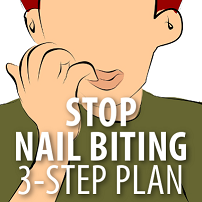104 Habit Reversal Training
Based on research by Azrin & Nunn 1973, Azrin et al., 1982, written by Juanita n Baker, Ph.D.
Do you or your child have an oral habit you want to change, like thumb sucking, biting, chewing or sucking your tongue, nails, cheeks, lips? Habits like these are so automatic and well established that we just can’t say to ourselves, “Oh, I’ll stop,” and then stop it. What can we do?
Psychologist Nathan Azrin first developed and then refined Habit Reversal, a 2-hour session that turned out to be 95% successful after a two-year follow-up for adults and children. Two components were essential: 1. Awareness Training: examining the habit (e.g. nail biting) by identifying the early signs of the habit (like feeling the finger nail), the urge, when the target behavior or habit occurs, and in which situations it is most likely to occur. 2. Competing Response Training: e.g. instead of performing the habit immediately engage in a competing response when first noticing a warning sign. A competing response can be any activity, like making a fist or grabbing onto a nearby object and squeezing for 1 minute. Studies show squeezing only 5 seconds is not enough time.
So if you want to change an automatic habit you have, you can implement the Habit Reversal technique with the assistance of a professional psychologist.
References
Azrin, N. H. & Nunn, R. C. (1973). Habit reversal: A method of eliminating nervous habits and tics. Behaviour Research and Therapy, 11, 619-628.
Azrin, N.H., Nunn, R.G., & Frantz-Renshaw, S.E. (1982). Habit reversal vs. negative practice treatment of self-destructive oral habits (biting, chewing or licking of the lips, cheeks, tongue or palate). Journal of Behavior Therapy and Experimental Psychiatry, 13, 49-54.
Twohig, M.P., & Woods, D.W. (2001). Evaluating the duration of the competing response in habit reversal: A parametric analysis. Journal of Applied Behavior Analysis, 34, 517-520.





